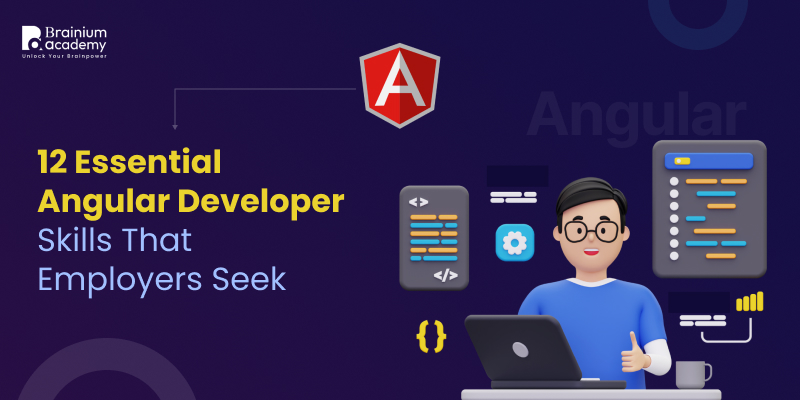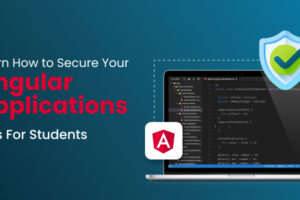
12 Essential Angular Developer Skills That Employers Seek
Since its release in 2010, Angular has surged in popularity as the go-to framework with the capacity for crafting high-performing web applications. Big names like Samsung, Forbes and Microsoft are using Angular for their web apps, so it’s clear, this is a framework to be reckoned with. As it enjoys collaborative community support and extensive features, the front-end framework backed by Google is a favorite among both developers and users.
Why Angular Development is a Promising Career Choice
The surge in demand for dynamic web applications and the growing popularity and adoption of the Angular framework has dramatically expanded the demand for Angular developers. Angular developer skills are now a must-have in the IT sector.
Developers use this platform to build stunning web applications that can be easily maintained, can handle varying amounts of load, users, data etc., and is designed keeping user-centric efficiency in mind. Companies understand the value of Angular apps, so developers in this specialization can expect lucrative careers.
The framework will continue to evolve and be relevant in the web app development market, thanks to its backing from Google. An active developer ecosystem contributing to tools, resources and libraries as well as regular update releases indicates that Angular is here to stay. You can look forward to a fruitful and enduring career with the required Angular developer skills.
How Angular Applications Work
What developers find appealing about using Angular is that it has a component-based architecture for building web apps. The web app is structured in a way that uses self-contained components, which is what basically makes up the user interface of the app. The components hold within them a portion of the UI together with its corresponding data and logic, so the code becomes modular and reusable.
Angular applications use a declarative approach to UI development, where HTML templates are enhanced with Angular’s powerful directives. These directives allow developers to create dynamic content and handle user interactions seamlessly. Angular’s two-way data binding ensures that any changes in the model (JavaScript objects) are automatically reflected in the view (HTML) and vice versa, simplifying the synchronization between the UI and the underlying data.
UIs are programmed with a declarative-style, utilizing HTML templates reinforced with Angular’s in-built directives. With powerful directives , developers can create dynamic content and handle complex user interactions or other conditions without friction.
Broken down into small, stand-alone “services”, Angular has components that work by leveraging reusable logic. The code separation means that even complex apps can be managed with ease. You would be working with mini-programs (services) loaded with specific tasks that can talk to other services. This is because, while they are loosely coupled together, they are not fixed together. Through the mechanism of dependency injection, injectors can be created for application-wide use. They handle and resolve dependencies, leading to apps that can be easily tested and maintained.
12 Essential Angular Developer Skills
1. Proficiency in TypeScript
For Angular development, TypeScript (a programming language built on JavaScript) is used. Developers would need to become proficient in this language as the type-safe environment will help them catch errors and bugs before they reach runtime. For a job in Angular, you would need to be well-versed with features like classes, interfaces, static typing, decorators and so on, as these will help you write well-structured and clean code. Plus, with TypeScript, developers can refactor their code, reducing complexity and improving its readability. This way, the app will evolve to accommodate changing user expectations.
2. Component-Based Architecture
To work on the Angular framework, you would need to learn component-based architecture. What developers will enjoy is working with components that hold within them their own style, logic and template, so it’s easy to manage and will not have issues affecting any other components of the app. You will also need to know how to use component lifecycle hooks to carry out custom logic and operations at different phases, while components are either being created, updated or destroyed.
3. Angular CLI (Command Line Interface)
When it comes to tools, Angular CLI is one you cannot do without while making responsive web apps. Once you have picked up how to use the Angular CLI, it will smooth the way for a bunch of development processes, including code generation, project setup and testing. Live loading gives you instant previews of code changes. This enables rapid iterations in CLI’s in-built server, ng serve. You will also need to know how to customize a project’s structure in the CLI such that it accommodates multiple environments and specifications. What’s more, for existing apps, you can add new elements, modules, services, and components via the CLI without expending too much effort.
4. Data Binding Techniques
To avoid tedious scripting and programming, data binding is the key. As far as Angular developer skills go, you would need to know how to use several data binding techniques, namely, event binding, one-way data binding and two-way data binding among others. The web app’s UI and its data need to be connected if they are to function correctly. Through automatic synchronization, data binding streamlines the flow of data between them. With these techniques, developers need to learn how to create data-driven web apps that offer excellent user experience.
5. Directives and Pipes
In Angular web development, directives serve the function of giving HTML elements with further capabilities by adding custom behavior. You would need to know how to use Component Directives, Structural Directives and Attribute Directives to customize behavior or modify the DOM structure (Document Object Model) in Angular. Also, you would have to know how to use the built-in or custom pipes in the Angular framework. These pipes are used for data transformation, where each pipe resolves a particular problem, formatting, validating or converting the data as required. As a developer you would need to be trained in using these mechanisms to transform data in Angular apps.
6. Routing and Navigation
While creating Single Page Applications (SPAs), routing is vital as it helps to navigate between different components or views without a page reload occurring. You can define the route of the application with the help of Angular’s Router module. It helps to manage route parameters and handle navigation within apps. It allows for faster page transitions as only the required data and components get loaded. You would need to know how to set up and navigate between routes, pass route params, guard routes and so on all, in an effort to create a logical and secure navigation experience.
7. Reactive Programming with RxJS
The RxJS library enables Reactive programming within the Angular framework by performing asynchronous tasks like user input or HTTP requests. To manage data streams and handle events, it is crucial for Angular developers to know RxJS core features including observables, operators and subscriptions. They would need to handle operators including filter, map, tap, catchError, forkJoin and so on. This reactive library that’s bundled into Angular allows you to create data-driven apps that respond to real-time updates and changes.
9. State Management
Apps with bulky data communications and high complexity, where components need to synchronize or share data need effective state management. You would need to use the NgRx library, which offers a Redux environment for developing dynamic web apps. App data will remain consistent and predictable when state management is carried out properly. Developers would need to know state management mechanisms like actions, reducers, selectors, and effects in order to build web apps that are consistently scalable and maintainable.
10. Testing and Debugging
Front-end Angular developers need to test their code to ensure it is of high quality and can be relied on in different environments. You need to work with Angular tools like Protractor (end-to-end testing) and Jasmine (unit testing). Individual components of apps, like, services, pipes and directives, need to undergo unit testing to verify their functionality. This way, at the preliminary stage of development, bugs can be spotted and fixed, saving costs and efforts. TestBed, async and ComponentFixture are some of the testing utilities developers need to be familiar with.
Once issues are caught, developers need to debug the code, an unskippable aspect of app development. Often, poor debugging can create more problems than it solves, so this is an important skill to have. There are a range of debugging techniques and popular tools, Angular DevTools and Chrome DevTools to inspect the component structure and resolve issues and bugs before it is made available to the general public.
11. Performance Optimization
Business web applications are primarily built on Angular thanks to its highly optimized performance. In fact, poor user experience is one of the primary reasons why a user might switch to a competitor’s app. Lazy loading, partial template loading, change detection strategies, and efficient rendering are some of the techniques that you would need to be familiar with. Build tools like Webpack are helpful for source code bundling and for optimizing the web apps’ size and performance. You can use several performance tools to check for bottlenecks, spot memory leaks, memorize function calls and more in order to improve the web app.
12. Version Control and Collaboration Tools
As part of web app development best practices, developers will need to be proficient in version control systems like Git Workflow. This is essential as the whole Angular team needs to be on the same page, being able to track changes made over time, manage merge conflicts and different versions of code. The testing and deployment processes are done automatically with CI/CD pipelines. Developers who are familiar with the pipelines are able to maintain exceptional code quality and accelerate time to market.
Why enroll in an Angular Advanced Course
An Angular advanced course gives developers the leg-up they need to take on more challenging projects and advance in their careers. With instructions from expert professionals, these advanced Angular courses build up Angular developer skills by ensuring they are well-versed in the latest features and industry best practices. The framework is constantly evolving, so the skills need to constantly be updated.
You would learn to refine the performance and functionality of Angular web apps, carry out state management with NgRx, test-driven development, data modeling, practical experience in performance tuning, code testing, data modeling, optimizing enterprise-level web app performance.
These include projects that are hands-on and based on real-world scenarios, this means you gain skills that can be applied in actual settings. It helps in mastering complex concepts, giving you the confidence to work on large-scale development projects. What’s more, developers get access to guidance and feedback from experienced instructors on a one-on-one basis, they learn Angular advanced concepts, ensuring that every aspect is thoroughly grasped.
Training from an advanced Angular course can significantly make a developer’s resume stand out from the rest, giving them the edge they need for a successful career. With enough confidence and skills, it can open up leadership opportunities and put you in a far higher salary slab. With advanced Angular developer skills, professionals in this specialization are able to excel in their careers, contributing consistently to their teams and projects.

